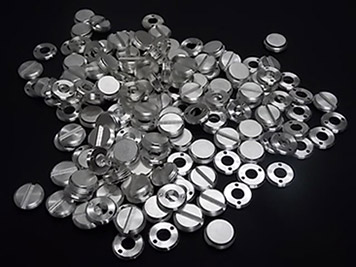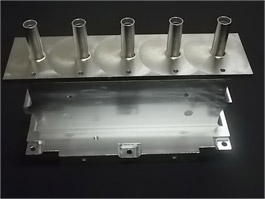The silvering processo for decorative purposesThe silvering process is widely used, as well as for decorative purposes, in many applications in the electronic, space, defense, microelectronics and telecommunications sectors in general. |
|
Choice of the substrate or barrier layer:
|
|
Main silver features are:
- Density: 5.10 g / cm3
- Melting point: 962 ° C
- Good brazeability
- Excellent electrical and thermal conductivity (the highest among all the metals)
- Low contact resistance
- Good corrosion resistance (depending on the base material, the intermediate layer and the thickness)
- Good anti-seizure characteristics (for static seals, bushings, ...)
- Reflectance to visible light, the highest among all metals (optimized value with gloss finish)
Two types of silver are available:
> SEMI-GLOSS SILVER
|
|
Electrolytic deposit of high purity silver obtained by galvanic bath with special additives to refine the grain and give it an appearance between the semi-gloss and gloss without negative interference in the RF-HF applications. This treatment is widely used in the telecommunications sector, in military and space applications and wherever high electrical performance are required, combined with good wear resistance. |
This type of silvering meets the requirements of standards:
• QQ-S-365 (Type II - Grade A or B
• ASTM B700-97 (Tipo I – Grado D – Classe N o S)
Characteristics:
- Semi-glossy / polished appearance function according to the type of finish of the surface that must be treated and the applied thickness;
- Hardness: 90 ÷ 130 (Knoop)
- Purity: 99.9%
- Good wear resistance (for example sliding contacts, with minimum recommended thickness of 20- 25 microns)
- Highly polished for mirror finish
>PURE/MATT SILVER
Electrolytic deposit of silver obtained by galvanic bath free of any type of additive, which guarantees the absolute absence of co-deposition of organic substances: this treatment is particularly suitable for vacuum applications and in the semiconductor industry. The use of special current rectifiers allows to refine the grain of the deposit and to improve the thickness distribution.
This type of silvering meets the requirements of standards:
• QQ-S-365 (Type I - Grade A or B)
• ASTM B700-97 (Type I - Grade A - N or S Class)
Special features:
- White-opaque appearance (or slightly semi-gloss depending on the type of finish of the surface that must be treated and the applied thickness)
- Hardness: max 90 (Knoop)
- Purity: 99.9% min
- Good weldability for "bonding"; (thermal compression)
- High ductility and absence of internal tensions which make it suitable for high thicknesses (up to 150 microns).

 IT
IT  EN
EN 








